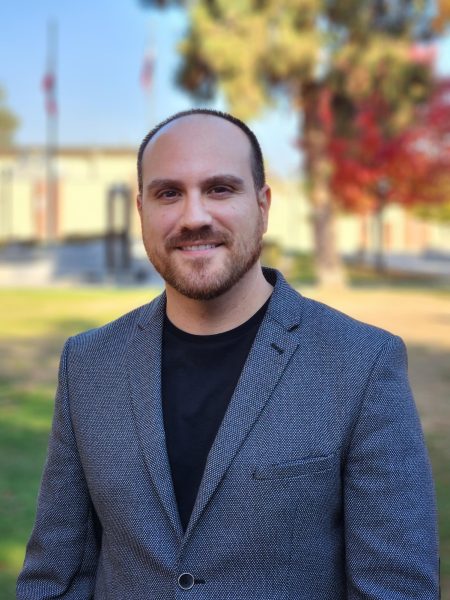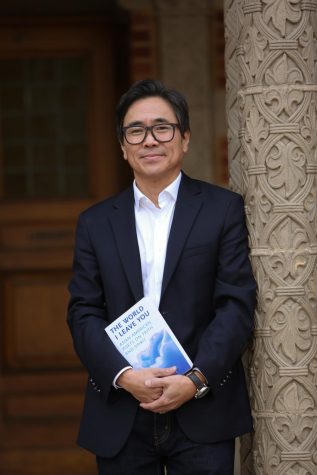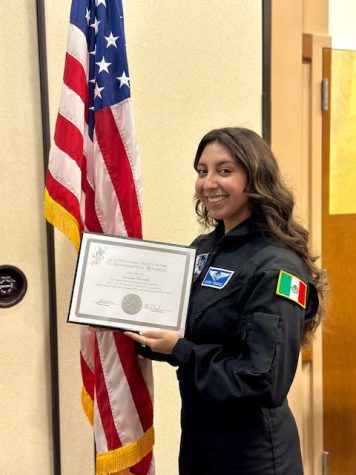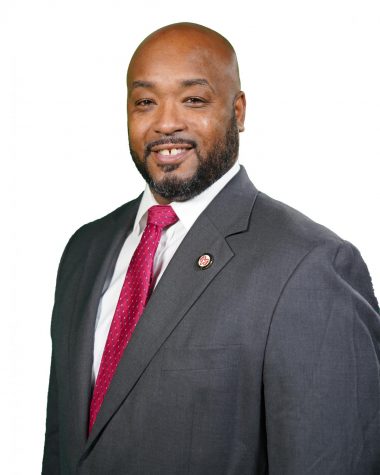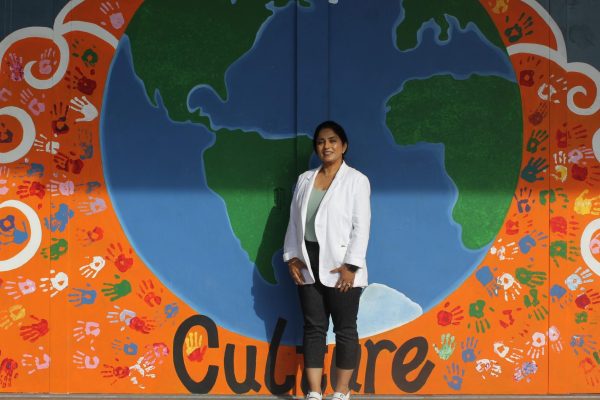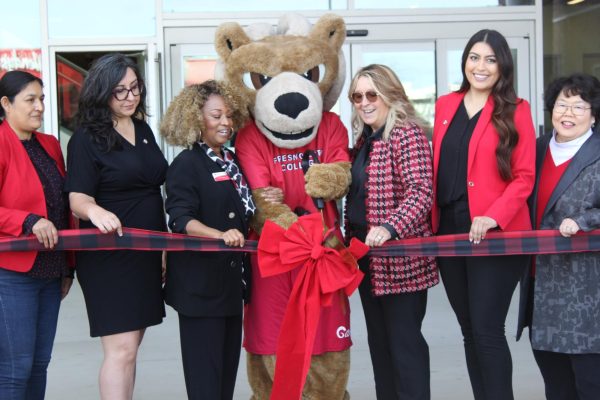Shame, Stigma, Misinformation Compound Food Insecurity Problems
Photo by: Ram Reyes
For the typical college student, sitting through class is an annoyance. For students who suffer from food insecurity, class is a constant struggle.
Close your eyes and visualize the word hunger. Many people imagine an emaciated person, their ribs showing, probably homeless and living in filth.
You may conjure up a family with both parents unemployed, on a street corner with a sign, soliciting your help.
That is not always the case.
Dozens of men and women huddle together on the outskirts of the Poverello House, waiting their turn to enter the facility for breakfast, lunch or for a number of other services.
And then there are the students.
They are sitting in class trying to concentrate, tapping their pencil and gripping an aching stomach. Their eyes sneak to the clock.
The only thing on their mind is rushing to the food bank for tonight’s dinner.
For the typical college student, sitting through class is an annoyance. For students who suffer from food insecurity, class is a constant struggle. Food pantries become lifelines. The donations of strangers become essential to survival.
What Is Food Insecurity?
The Department of Agriculture defines food insecurity as, “the lack of access at times, to enough food for all household members,” according to DoSomething.org.
Food insecurity is experienced everywhere: in every country, in every state, in every county. According to DoSomething.org, food insecurity is not a factor due to lack of food, as the world has more than enough food to feed every person on the planet. Instead, the primary cause is poverty.
“Malnutrition can lead to growth failure. Principal types of growth failure are ‘stunting’ and ‘wasting.’ Stunting is a slow process caused by a lack of nutrients and wasting is caused by insufficient protein,” according to The Borgen Project.
Who Is Hungry?
Every day, 821 million people worldwide are chronically undernourished, according to November 2017 statistics by The Hunger Project, a nonprofit focused on the eradication of global hunger.
Ninety eight percent of the world’s undernourished people live in developing countries, and it is most prevalent in Asia, affecting 515.1 million, as well as 236.5 million in Sub-Saharan Africa, and 32.2 million in Latin America, according to The Hunger Project.
In an article published April 2017, according to the World Bank, 896 million people in developing countries live at or below $1.90 a day.
According to a 2017 article by The Borgen Project, a nonprofit focused on global hunger, around 794 million people or 10.9% of the global population were undernourished worldwide.
Seventy five percent of the world’s poorest people live in rural areas and depend on agriculture and related activities for their livelihood, according to The Hunger Project. “Yet, 50% of hungry people are farming families.”
United States
According to a 2019 article on DoSomething.org, one in six people in the United States face hunger and 45 million Americans struggle to put food on the table.
As of July 2016, 20% of American food insecure families are not eligible for government assistance, according to Mashable.com.
Forty percent or about $165 billion worth of food is thrown out in the U.S. every year. That’s enough to feed 25 million Americans, according to the most recent report published in 2014, on DoSomething.org.
California
In California, 4.6 million people, almost 12% of residents have food insecurity. A total of 7.9 million people in the state live in poverty, according to Cafoodbanks.org.
Fresno County
In 2014, 29.2% of children in Fresno County had food insecurity, according to a hunger-count.org report. A 2016 survey on countyhealthrankings.org reported that 155,600 people or 17% of Fresno county residents lack access to food.
Causes of Food Insecurity
Institutional Challenges
Among factors complicating access to food are government regulations and red tape.
Ara Guekguezian, pastor of Community United Church of Christ said challenges in dealing with institutions and structures can lead to food insecurity.
“It is a shame to call yourselves the bread basket or the food basket of the world, and you have some of the highest rates of food insecurity, particularly among children,” he said. “I think that’s shameful.”
Marilyn Wall, administrative assistant for Community United Church of Christ said that residents of the Central Valley are blessed with resources, but “we don’t do anything with it.”
The Working Poor
A sizable portion of food insecure people belong in families of people who are classified as the working poor.
According to the U.S. Bureau of Labor Statistics, the working poor comprised 6.3% of all individuals in the labor force or about 9.5 million people.
In 2014, 11.7% of the working poor population comprised of African American, 11.7% Hispanic/Latino, 5.5% White and 4.3% Asian.
Most times, working class people must choose between meeting their obligations and feeding their family. Guekguezian said he understands how hard hunger can be for children who need proper nutrition to develop properly.
“It’s not an 8-year-old’s fault that there’s no food in the house, and forget all the Christian faith stuff, righteousness all that,” he said. “It’s the best investment we make — giving children the chance to be healthy until they are fully shaped and formed.”
The pastor said that the main factor in food insecurity is the economy. “The minimum wage hasn’t kept up with [the cost of living],” Guekguezian said. “It’s not the minimum wage that allows for you to live life; it’s the minimum I can pay you by law.”
He also said that most companies are not concerned about what happens to the employees once they clock out.
“‘I don’t care whether you can live off this or not,’” the pastor said, describing employers’ attitudes. “And for me, that’s a spiritual question; it’s a moral question. If I give you my labor, I ought to be able to live off of that. I ought to be able to live off my labor.”
He added that emphasis on acquiring new technologies contributes to money mismanagement. because people are forced to choose between a meal or a commodity.
“Like you have to have access to communication,” Guekguezian said. “Your smartphone, your access to the internet in the house for entertainment options, and so forth, that can be costly.”
He explained that it is like not being able to afford a meal but going out to buy a car — a nice car instead of eating.
“But if I have an 8-year-old child and I make that decision,” Guekguezian said, “that’s not that child’s fault. And then, they’re malnourished and don’t grow up to be all that they can be.”
The Community United Church Of Christ ministry helps members of their own congregation by feeding them at their own church. And they also take up a collection for food and take it to Hope Lutheran, a nearby church which Guekguezian says has a ”terrific food pantry and program.”
Wall said people line up every Tuesday to collect food.
“It’s not homeless people. It’s regular people that live in apartments, that have their cart; they got the bags and they’re walking,” she said. “They’re you and me.”
Although not all these people are homeless, Guekguezian said he realizes that the cost of housing also plays a part in going hungry.
“It is the high cost of housing,” he said. “It eats up so much of the income of people that are at the poverty level, lower income level, even the lower middle class.”
He said that if a family earning $2,000 a month pays $1,400 in rent, they must cut back on some need. In many cases, they cut back on food.
Food is a basic necessity, Guekguezian said. “You know that thing of being full? That’s a basic joy. It is a basic human joy, and going to bed hungry, where it’s not your choice, affects your spirit.”
Lack of Awareness
“One of the biggest challenges we face is the lack of awareness on the current state of food insecurity in the valley. That lack of awareness also spreads to the programs available to individuals in need,” Hamid Akbar, an associate of Masjid Fresno Muslim Center, said.
“Many individuals are also afraid to ask for help and visit the programs, in fear of their legal status being questioned,” Akbar said.
According to Akbar, some individuals are deterred by practical issues such as transportation.
This results in people going hungry and becoming, “Less than they could have been, and it [food] was right there,” Guekguezian said.
The Stigma
Few struggling with food insecurity wish to be identified, fearing the shame and ridicule that comes with poverty, and having less.
Josh M, a talented welder, is one of the many millions affected by food insecurity. He stays up late tinkering on a custom scooter he is building. Connecting a throttle linkage cable is one of the final steps before he preps for a test run. He has rebuilt the motor and welded a custom frame over a long period of time with his limited income.
He hopes to start his own bicycle frame company and is taking classes at Fresno City College to obtain the certificates and knowledge necessary to run his own business.
Unable to work, Josh relies on various government assistance programs. He is able to buy some groceries thanks to CalFresh government assistance.
“It is still not enough,” he said. “It doesn’t cover our housing, or the necessities for the kids the way it should, but if I didn’t get at least that, I don’t know what I would do.”
“I can weld,” Josh says. “But nobody wants to hire me; nobody wants to hire anyone with a criminal record; my only options are under-the-table construction, field work, or selling drugs.”
He said that there is a stigma attached to jail time and “nobody wants to trust you because of it.”
Only recently has he benefited from the programs in place by the state to cover food and the little cash aid he receives.
Before receiving assistance, Josh would rely solely on the money he would make selling various narcotics to cover these living costs, bartering drugs for cash, and even shoplifting groceries.
“These were things I need, and that was a means for me to get them,” he says, “my options were very slim.”
Josh is building his scooter for a means of transportation for himself to reduce the cost of gas to get to school.
He hopes that obtaining an education will help him change his life. He hopes to find employment and end his reliance on government programs.
He worries about his children, their future, and the examples he sets for them. “I don’t want them to have to go through what I’ve dealt with,” Josh says.
For him, school is his only option.
Josh isn’t alone in this struggle. According to a 2016 Hunger on Campus report which surveyed 3,700 community college students, 25% experience food insecurity. Additionally, 13% experience homelessness.
Potent Combination – College, Single Parenting & Limited Finances
Causes vary greatly–financial instability, ballooning cost of housing and tuition, and lack of real world work skills, can all make it difficult to maintain the costs associated with a family. Other variables including life events can negatively affect a person’s financial situation.
For Connie L, a returning student and single mother, life changed dramatically after her husband died and she moved back to Fresno from Texas. With no work skills and no degree, Connie would not be able to provide for her daughter with a conventional job.
“In order to afford my own place, utilities, groceries, a car and everything else that comes with life, I would have to work three jobs at minimum wage,” she said. “How can anyone do that?”
She too relies on government programs for assistance with groceries and living costs.
“School would not be an option to me without it; I would have to work three jobs, never be home, never see my daughter, and never move forward in bettering my life because I am stuck just trying to make enough for that,” she said.
Losing any of her assistance could mean quitting school to find a job to provide the extra income needed to cover those costs.
On a limited budget, Connie brings herself small snacks and fruit to eat throughout the day to avoid the cost of eating on or around campus.
“I feel guilty eating out and spending money on food when I know my daughter is at home eating a peanut butter jelly sandwich,” she said.
Rather than risk the uncertainty of managing living on her own, she shares accommodations with her sister and mother, who help with her daughter while she’s in school.
“I want a house, or at least a place of our own for me and her, but I can’t afford that without an education,” she said. “I can’t get an education and take care of my daughter without help.”
In her first semester back, Connie has made the Dean’s List and now qualifies for financial aid. Still, she said she must sacrifice the things she needs for school in order to cover utilities and expenses for her daughter.
Youth, Gender Divide
“I’m going to live with Daddy, Mommy, because he has money and hamburgers, and you are poor with no food!”
A startling 60% of the world’s hungry are women, according to the Food and Agriculture Association of the U.N.
According to a 2017 report by the USDA, “Food insecurity rates for households with children headed by a single mother [30.3%] and for women living alone [14.7%] are very high.”
Pay discrimination due to gender, gender-based violence, inadequate federal nutrition programs and benefits, motherhood care and responsibilities, pregnancy risks, and even race are a few factors that predispose women to poverty, thus leading to hunger.
“Women are also more likely to work in low-wage, part-time jobs with no benefits,” according to Bread for the World, a Christian advocacy group focused on hunger and poverty.
Food deficiency is a never ending cycle for women who can’t find adequate work. “One in three single mothers struggles to feed herself and her children,” according to Bread for the World.
“Malnourished mothers are likely to experience numerous health risks during pregnancy,” according to the Food Research and Action Center.
“Malnutrition during pregnancy increases the risk of mental illness. Studies investigating famines reported increases in the rate of schizophrenia during periods of prolonged prenatal exposure to hunger, or ‘nutritional inadequacy,’” according to The Borgen Project.
Intolerance
Food insecurity has been gradually rising in recent years among college students in general.
Aaron K. said he never experienced food insecurity as a student until last year.
He works part time at a Family Dollar store and struggles to cover the costs school has incurred. His small paycheck covers his gas, insurance, and some utilities he pays for. He lives with his sister and her two elementary school aged children after breaking up with his boyfriend after nine years.
Before moving in with his sister, he would spend his nights floating from one friend to another, sleeping on a couch, sometimes in his car parked in a Walmart parking lot.
When Aaron was 16 years old, he came out to his family as gay.
“My stepdad couldn’t take it. We had a big fight, and I left,” he said. “My mom didn’t even seem to fight for me; she just went in the room and cried.”
His father left him and his mother when he was only 4 years old.
“I never knew him. I have memories of him, but he never came back,” Aaron said. “We don’t talk; I don’t know what happened to him.”
At 16 he began staying the night at friends’ homes, sometimes for as long as two months, other times for as little as a few days, until he moved in with his much older boyfriend, less than a year after leaving home.
“I didn’t finish high school because of it, I later finished my GED because he made me,” Aaron said. “But living with him was comfortable; he provided. I just worked small part time jobs to pay for things I wanted and to help him how I could.”
When the relationship ended, he left again, and moved in with his younger sister.
“I don’t make enough to afford my own place. I can barely afford my car, and the only reason I keep it is for school and work,” he said. He budgets for everything: food, clothes, school and gas, but it never seems to work out.
Aaron often feels that he isn’t pulling his own weight, and feels guilty for relying on his sister. “I know she doesn’t have much money, like anything she wants to share with me, is taking something from her kids.”
For now, Aaron continues to go to school where he studies business. One day, he hopes to pay his sister back for her generosity.
Effects
FRAC reported that 28.3 million (11.5%) and 12.9 million children (17%) suffered from food insecurity in 2016.
According to the Office of Disease Prevention and Health Promotion, food insecure adults have an increased risk for obesity and chronic disease.
Food insecurity is linked to impaired academic performance in boys and girls, weaker social skills for boys, and greater weight gain for girls, according to a 2005 study published in the Oxford Journal of Nutrition.
Sadly, these developmental effects of food insecurity continue to affect children into adulthood. According to a 2017 study published by Cornell University, impoverished children experience more psychological distress and exhibit more antisocial behavior in adulthood than children from non-impoverished backgrounds.
According to a 2017 FRAC report, people and families suffering from food insecurity are often forced to make financial decisions that are harmful to their overall health. Families suffering from food insecurity must often choose between food and their utilities.
Moreover, the damage of food insecurity extend far beyond hunger. The same FRAC report said that some people suffering from food insecurity choose to skip doses of medicine to afford food. Others may choose to postpone needed medical care or disregard health-related dietary restrictions.
As a result of sacrificing health guidelines for a full stomach, food insecure households often exacerbate their conditions if they become ill. The report mentions failure to adhere to a diabetic diet can lead to poor glycemic control in diabetic patients.
But of all demographics, the most vulnerable to food insecurity is the disabled. The Center on Budget and Policy Priorities finds that people with disabilities are twice as likely to suffer from poverty and food insecurity than the non disabled population. In fact, 33% of food insecure households have a member of working age who is disabled.
The impact of food insecurity can be felt even in food secure households. The Iowa Food Bank Association reports that the higher rates of illness among people suffering from food insecurity places a large strain on the economy. Child hunger costs the federal government $28 billion annually due to malnourished children having higher rates of absenteeism and requiring more healthcare later in life.
The Ram Pantry, SNAP, and the Poverello House
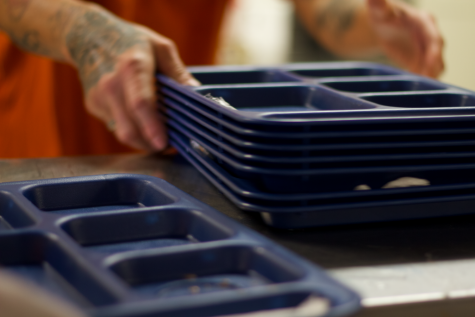
Empty trays left by those who attended breakfast at the Poverello House on April 26, 2019.
In 2015, Sean Henderson, dean of students at FCC, began to explore the idea of a food resource on campus that would be attainable to all enrolled students.
As a result of the idea, a committee of community members and FCC faculty collaborated to find a solution to the problem of food insecurity which an alarming number of enrolled students were facing.
“People were very committed to providing food for students because they believed that would help them to be more successful,” said Cindy Dunn, coordinator of the Ram Pantry. The plan was to eradicate a classic student dilemma: between buying food and buying a textbook.
Dunn explained that the commitment from the college staff members was so strong that some even took a reduction in their paychecks to give to the Ram Pantry, which is majority funded by donations.
“I have seen close to a doubling of students coming in,” Dunn said.
The Ram Pantry is open 30 hours a week and accommodates students’ needs and schedules.
The pantry opens Monday and Thursday from 10 a.m. to 1 p.m., reopening from 4 p.m. to 6 p.m. for athletes and students taking classes in the evening. On Tuesday, Wednesday and Friday, it is open from 10 a.m to 2 p.m.
The only requirement to use the pantry is a student I.D. They can avail themselves of all that the pantry serves, ranging from whole lunches and unlimited fresh fruit to pancake mix and spaghetti noodles.
Maurice Kelly, a former FCC student who used to get food from the Ram Pantry said he has muddled feelings about it.
“I feel like if you are going to have some food, have some food,” he said, adding that the pantry does not have a diverse enough selection.
“They are not giving real food — like salads and water, cold water, not warm water. I feel like everything should be refrigerated,” Kelly said. “Just like how they have at the café [Taher Campus Dining], it should be the same way.” The on-campus cafe’s food selection is wider, but not free, eliminating it from the options students like Kelly have.
Government Programs
CalFresh, the California implementation of the federal Supplemental Nutrition Assistance Program (SNAP) benefits, offered through FCDSS, helps provide food for hungry people. While it is another piece of the social safety net, it comes with various conditions that deter many who need their benefits.
SNAP beneficiaries must be approved for state or federal work-study money and are expected to work during the school term, or, they must be a full-time student with a child under age 12, or a part-time student with a child under age 6, or be part-time with a child 6-11 who lacks adequate child care.
Those already receiving CalWORKS, a jobs program, will qualify. Those enrolled in CalFresh employment and training or another job training program accepted by CalFresh will qualify.
Many students meet one half of the criteria but not another. Many meet all the criteria but struggle to verify it.
An October 2018 article in USA Today identified Fresno as having a high rate of SNAP beneficiaries. 21% of Fresno residents receive SNAP benefits, and the city ranked 16 out of 25 cities in the U.S. in the number of households on SNAP benefits.
Fresno Safety Nets
The Poverello House offers numerous services from food supply, overnight shelter, and an emergency shelter voucher program, according to Sara Mirhadi, chief programs officer of The Poverello House.
Emergency shelters like the Marjaree Mason Center benefit from their relationship with the Poverello House, which provides two meals a day to those staying at the shelter.
The intersection of hunger and domestic violence is a difficult choice between fight or flight: either victims will stay, remaining fed but facing violence each day, or they will leave and face hunger.
The latter often means fleeing to the Marjaree Mason Center, or to the Poverello House.
Despite federal aid, nonprofits, and on-campus resources, food insecurity remains prevalent across Fresno County, California, the U.S. and globally.
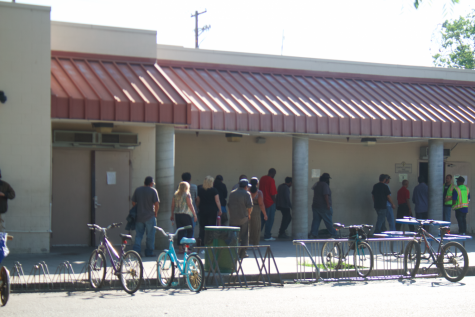
A line outside the Poverello House on April 26, 2019.
The Masjid Fresno Islamic Center
The Masjid Fresno Islamic Center is at the forefront of feeding the hungry in Fresno and often invites the community of all faiths to dinner.
The center also provides lunch and activities for the community in its neighborhood community picnic once a quarter to foster good relations among the residents and business owners of the Sierra Madre neighborhood, said Akbar, an associate of the center.
“The Masjid distributes food to 40 to 50 families twice a month, [first and third Sundays from 8-10 a.m. at Masjid Fresno] which equates to approximately 175 to 200 individuals,” said El Sayed Ramadan, Imam of Masjid Fresno.
“In 2018, 45,785 pounds of food was distributed,” he said. Through their food distribution program, the center has been able to reach an extensive amount of the food insecure population in Fresno.
Akbar said the distributed items include “nonperishable items such as oil, rice, cereal, macaroni and cheese and juice” as well as perishable items like bread, pastries, and seasonal fruits and vegetables.
The most popular items with recipients, Akbar said, include bread, pastries, rice, cereal, and macaroni and cheese, adding that the center serves people of all walks and all faith, older veterans, families, and elderly, “asking for food, coming via bus, car, or walking.”
“There isn’t a defined prevalence of demographics. We see a variance of ages and ethnicities,” Akbar said. “We also do not ask our participants for information on where they are from or their current circumstances,” Akbar said.
Akbar said he believes that food recipients should be treated with respect.
“As they leave, thank them for coming,” he said. “By treating all individuals with respect and dignity, you are letting them know that there are people who care about them and their wellbeing.”
Akbar said he believes that the benefit to the community is immense. First, healthy foods support nutrition and gives them [the hungry] hope that the community they live in supports them when they are in need.”
Additionally, this food allows the food insecure to focus on other areas that can support their families without the stress of how they are going to eat.
Masjid Fresno also assists the community in a variety of ways. The mosque is affiliated with Muslim Society of Central California which holds a free health fair twice a year.
Imam Ramadan said it is important for places of faith to get involved in helping the community in every way possible. “All places of worship need to open their doors to those in need by providing food by working with organizations such as the Central California Food Bank.”
Akbar said feeding the hungry should be continuous, “not only giving food on a scheduled basis, but opening food pantries that can support the communities at all times.”
“Human dignity is very important,” said Ramadan. “Welcome them, [those experiencing hardship] with respect and open arms when they arrive, no matter their faith.”
Community United Church Of Christ
Wall, the administrative assistant for Community United Church of Christ, said people line up every Tuesday to collect food.
“It’s not homeless people. It’s regular people that live in apartments, that have their cart; they got the bags and they’re walking,” she said. “They’re you and me.”
Wall said that the church fills gallon-sized ziplock bags with bottled water, sandwiches made with baked bread, chips, cookies, nuts, mandarin oranges, and socks to give away to hungry people.
On Sunday, March 17, 2018, the church distributed more than 100 such bags on Eaton Plaza and G Street near the Poverello House area in less than five minutes.
Guekguezian, pastor at Community United Church of Christ, said, “We [also] made little bags with [detergent] pods and fabric softener and distributed more than 200 of those at 10 laundromats around town, near apartment complexes because those are the folks who use them.”
He also said that becoming engaged in the community, recognizing the needs and and participating in addressing that need “fills something in you, and the world becomes less scary.”
The Marjaree Mason Center
Most people wouldn’t correlate domestic violence with hunger, but the narratives of the women and families who take shelter at the Marjaree Mason Center say otherwise.
“We try to assist the community in any way we can, and although we do focus on domestic violence, we help anyone that comes through our doors, and most of the times they’ve been hungry,” said Rouby Mavyan, an emergency services manager at the center.
“That’s the first thing we ask them, ‘Are you OK? Do you need food? Are you hungry?’ And a lot of the times they are, especially the ones that come with children. It is heartbreaking.”
Mavyan said that their clients become homeless mostly due to domestic violence, which means the victims leave their home unexpectedly.
“They have no money; they have no food. So when they come into shelter, finding their own food becomes a barrier.”
Sometimes children are affected by the abuse as well and may effects of starvation, used a tool for control by perpetrators of violence.
Mayvan said that in most cases abusers who have children with their victim will target the victim with food deprivation, rather than the children.
Most of the time when children come into the shelter and they are hungry, it is because the victimized parent has had to sleep in their car for a day or two and didn’t know where to go for emergency services, Mavyan said.
Often times, when these victims work or attend school, their abusive partner will show up to their job or school, stalk them, harass them and get them fired, leaving them without income and a means to provide for their families.
“There have been instances where a victim has returned to us five, six times either with the same partner issues or with different partners,” Mavyan said. This is a large part of the problem, and getting these victims to leave these dire situations for good is not always easy.
“They say it takes a victim anywhere from six to nine times to finally leave an abusive relationship,” Mavyan said. “So, we’ve had instances where they become homeless because of domestic violence, and they are left without food; they are left without money.”
Some of the victims lack proper documentation and do not qualify for county services such as cash aid or food stamps, but the center provides for all.
“Once they come here we try to equip them with the tools either, to get up on their feet to find employment or to get any type of aid or connect them to any agency,” Mavyan said.
The center also assists about 10-20 percent of homeless people who aren’t victims of domestic violence with food.
Clients typically stay at MMC and average of 30-31 days. Those that come simply for food, are packed little emergency kits with snacks and juices and if Poverello has just been by they pack hot meals to go.
Community food banks, local churches, WIC and county assistance programs are all services that MMC helps their clients to utilize so they and their families don’t go hungry once they leave.
“We also let them know to come to us. We’ve had a lot of clients that have moved out where you know it’s the end of the month and food stamps haven’t kicked in yet,” Mavyan said. And yes, although they’ve left the facility, MMC still feeds these families.
Breaking the Cycle
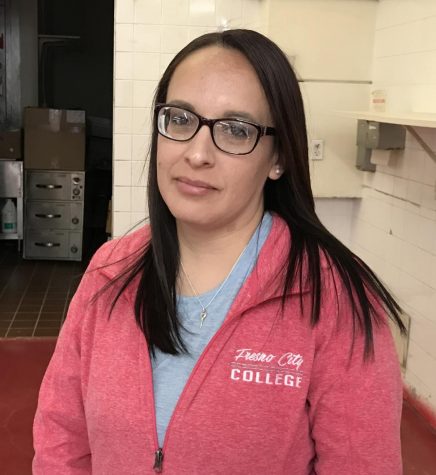
Kimberly Villalobos, 35, is a child development major returning to school for the first time in 15 years. Following her struggles with homelessness and poverty, Villalobos is trying to turn her life around now that she’s in a more stable financial state and living with her boyfriend.
Kimberly Villalobos, an FCC student, who found herself trapped between academia, homelessness, and hunger, is evidence that the cycle of hunger can be broken..
At 17, Villalobos fled her household and went to FCC straight out of high school. Her financial aid award went towards her rent and utilities rather than books. She would eventually drop out.
Then she took a janitorial job which brought her some stability.
“When I was working as a janitor, I started thinking about going back to school to better myself,” Villalobos said.
She returned to school as a 35-year-old, seeking a degree in child development and met her boyfriend, Henry Farias, whose family took her in. With a roof over her head and a full stomach, Villalobos started getting straight A’s.
“Now that I’ve returned, I feel set to start the path towards where I want to be in life,” she said.
The cycle leaves scars. “I still struggle with food,” Villalobos said. “I try not to stress about meals, but you never forget your past.”
Because of that past she makes sure to tell homeless FCC students about the Ram Pantry, and she continues to give back to the pantry.
“Now that I’m in a slightly better position, I try to donate whenever I can,” she said. “I try to think of everyone else who needs food.”
But even for people like Villalobos who have found a reprieve from hunger and the streets, the possibility of a downturn–of the pendulum swinging the other way–is always there.
According to a 2012 study conducted by the University of California, Davis’ Center for Poverty Research, 36 percent of individuals who manage to escape poverty will return to poverty within the next four years.
Giving Hope–More than Food
Guekguezian, pastor at Community United Church of Christ, said he is in the “hope business” and believes there’s always room for encouragement for people who may be down on their luck. “I like to make sure that the people [those he is feeding] understand that we are establishing a relationship.”
He reassures those who look to him for help that he doesn’t intend on abandoning them. “This isn’t a one shot deal. In everything we do, we’ll be here again,” he said. “This isn’t the first and last bag of food that we’re going to have available.”
Guekguezian said the hope comes out of the relationship that is established, “between you and me and that I have with God that moves me to do this, and moves us to do this.”
He said he hopes that the person he is relating to, sees that and “starts to think about that kind of relationship with the other human and then with the Divine.”
His focus is always on the person right before him. “The entry point or reentry point to the source of my hope, that the person I’m with has that or re-establishes that.”
Then, Pastor Guekguezian said, “You feel full.”

Tamika Angie Rey is a 32-year-old second year college student who is striving to become a professional journalist. She is currently majoring in journalism...
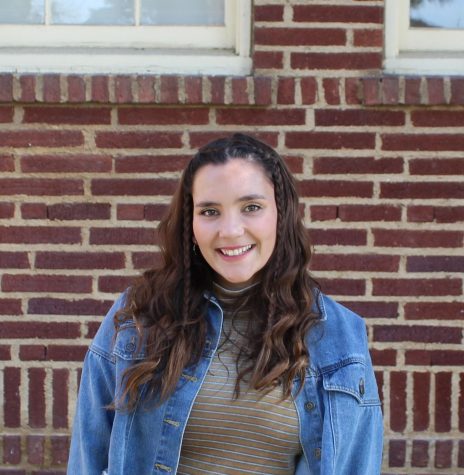
Hannah Lanier is the 20 year old New Editor and reporter for the Rampage at Fresno City College. Born and raised in Fresno, California, Lanier is the youngest...
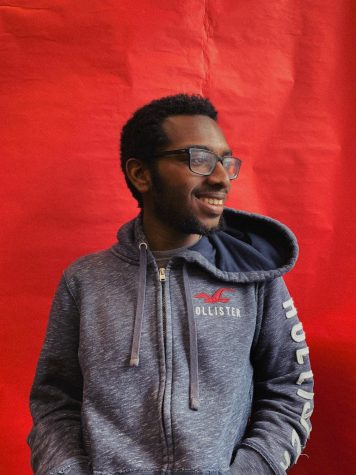
Blake Evans was born on June 24, 1999 and is an English major and aspiring journalist. He hopes to go into investigative journalism and uncover the next...

Leticia Leal, 19, is a fourth semester student at Fresno City College. She was born in Fresno and travels to Los Angeles often to visit her family. This...

Ramuel Reyes is a 23-year-old, currently living in Fresno, California. He was born in Lucena City, Philippines. After living five years in the United Arab...


